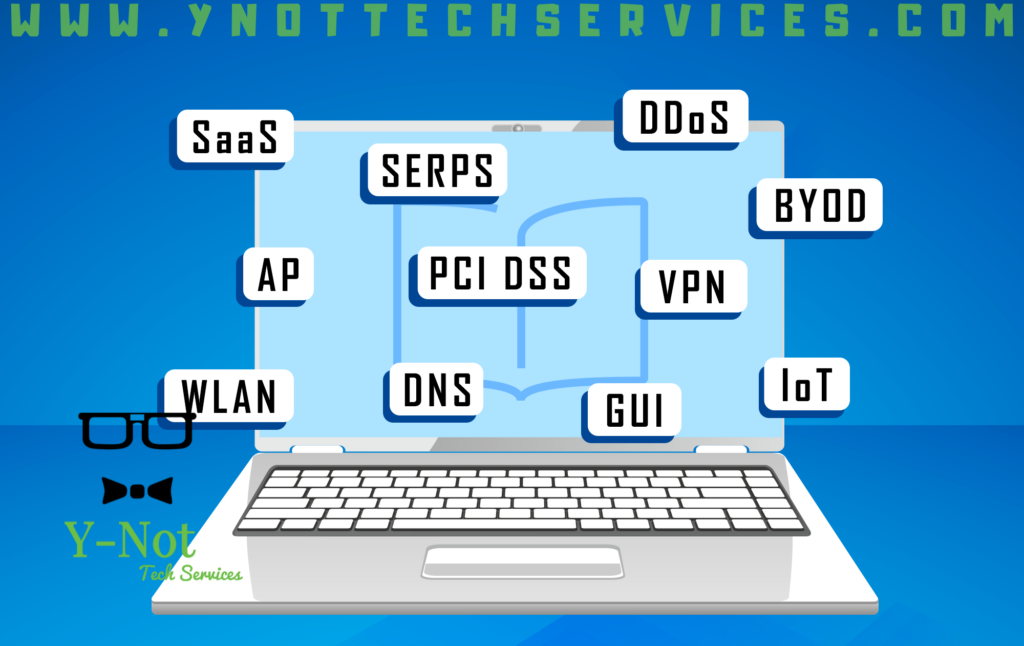 Crack the Code: Decode Top Tech Acronyms at Work
Crack the Code: Decode Top Tech Acronyms at Work
We’ve all heard about some of the classic tech abbreviations by now, such as CPU and RAM. However, modern workplaces are introducing many new ones. While there are thousands of tech abbreviations out there, here are some you are most likely to see in today’s business world.
Networking Related
VPN: A virtual private network allows remote employees to access office files and systems from anywhere as if they were in an actual office. Many employees are required to use a VPN to work from home and access work documents and printers.
IP: An internet protocol address is a unique number identifier for each device (such as a computer or smartphone) connected to a network. This is similar to each employee having a unique desk number to know where to send important memos but for network-connected devices.
IoT: The “internet of things” refers to devices that can connect to the internet and share data. Smart locks, smart lights, and doorbell cameras are examples of IoT devices.
LAN: A local area network connects computers within an office or building using wired or wireless connections. It allows devices to share resources on the network, such as internet access, files, and printers.
WAN: A wide area network extends connectivity between multiple office locations over a broader geographic distance. This is important for large or distributed companies to maintain efficient communications and resource-sharing between sites.
WLAN: Wireless local area networks provide mobility within an office using Wi-Fi instead of cables. People think of this when they use the term “Wi-Fi.”
VLAN: A virtual local area network divides one physical network into smaller software networks. It is often used so that one network, such as the Guest network in a hotel, cannot access the Hotel’s internal resources such as files or printers.
AP: An access point is the hardware device that transmits a WLAN’s Wi-Fi signal. Proper AP placement and configuration are important to receive a strong signal throughout a workplace.
Internet Related
SEO: Search engine optimization involves tweaks to improve a website’s ranking on search engines such as Google. This is important for driving qualified traffic to business websites from free, organic search results.
SERPS: Search engine results pages are what users see listed on search engines after performing a query. High SERP rankings increase a business’s chances of being discovered online.
SEM: Search engine marketing encompasses paid promotion methods such as Google Ads that immediately boost search visibility. It is useful for time-sensitive goals such as product launches or seasonal campaigns.
SSL: A secure sockets layer establishes an encrypted link for safely transmitting sensitive data online. In the offline world, it would be comparable to securely encrypting a confidential letter containing a client’s bank account numbers or social security details before sending it via the internal mail system. SSL protects sensitive cargo from prying eyes along the distribution chain.
HTTPS: The hypertext transfer protocol secure is a more secure version of website browsing that encrypts connections using SSL/TLS and is used on most websites these days. Still, it has always been essential on banking and e-commerce websites where sensitive information needs to be sent and received.
DNS: The domain name system translates human-friendly website addresses (such as www.google.com) into the numeric IP addresses that computers use to locate internet resources.
DDoS: Distributed denial of service attacks attempt to overwhelm websites or servers with malicious traffic to force outages.
Security Related
MFA: Multi-factor authentication requires multiple verification methods such as one-time codes in addition to passwords, strengthening login security. MFA reduces account takeover risks for both business systems and customers.
IAM: Identity and access management systems provide centralized control over digital user identities, authorization privileges, and access to business applications and data. In an offline world, it would be comparable to a receptionist controlling who can visit which floors based on employee IDs.
SSO: Single sign-on streamlines user authentication by permitting access to multiple associated accounts after one login. It improves the digital workplace experience while also reducing security vulnerabilities from multiple individual account credentials. For example, it would be like signing in at the front desk to access any conference room or lounge area.
PCI DSS: The payment card industry data security standard is an important framework for protecting credit card information during payment processing. It is designed to reduce payment card fraud by increasing security controls around cardholder data.
MSP: A managed security provider is a third-party company that monitors and maintains business security tools such as firewalls, antivirus software, and backup systems. An MSP also helps businesses streamline operations, develop expansion plans, and adopt new technologies.
Business
AI: Artificial intelligence capabilities can automate routine tasks, gain insights from large data volumes, and augment human decision-making. AI is enhancing business functions across many industries, such as customer service, fraud detection, and even creative work.
SaaS: Software as a service delivers business applications over the internet rather than through installed programs. The flexibility and low upfront costs of the cloud-based SaaS model have made it popular for functions such as accounting, collaboration, and customer relationship management. The Web version of Microsoft 365 apps or the accounting software Xero would be a good examples of SaaS.
APIs: Application programming Interfaces allow different systems and software to communicate and share data securely. For example, a third-party website that tracks Amazon prices would use Amazon’s API to get its pricing information.
SLA: A service-level agreement formally defines the quality of technology services expected from external providers such as cloud vendors. SLA metrics help hold suppliers accountable for uptime, response times, and other service attributes important to business operations.
CMS: A content management system allows non-technical business users to easily manage and publish marketing, product, and support information on company websites. A commonly used CMS is WordPress.
BYOD: “Bring your own device” policies address how employees can securely access business systems and data on their personal smartphones and laptops for work purposes.
General Computers
OS: An operating system manages basic low-level functions of devices and allows applications to be installed and run. Microsoft Windows and Apple’s OSX are examples of operating systems.
VM: Virtual machines emulate entire computing environments that run isolated from actual hardware. VMs improve flexibility, high availability strategies, and disaster recovery preparedness. This is often used to run legacy hardware and software that works only on older operating systems, such as Windows XP.
GUI: Graphical user interfaces provide visual menus, icons, and windows for the user to interact with. On old computers, we used to have to type commands, but these days, most people use a GUI where they can click on icons and open windows.
TTF: TrueType font files are a standard format for fonts that work on both Windows and Mac platforms. A TrueType font can scale to any size without pixelating.
I hope this helps you follow along with some of the technical conversations happening in today’s digital workplaces. And, who knows? Maybe you’ll even find yourself using a few of these abbreviations too!
If you need help understanding any other tech, reach out today, and we’d be glad to help.



